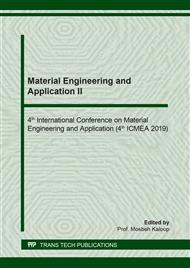p.82
p.87
p.94
p.99
p.103
p.108
p.114
p.119
p.124
The Green Preparation of Cellulose Fibrils from Oil Palm Leaf Stalk Fibers for Hydrogel Applications
Abstract:
In this study cellulose fibrils were successfully prepared from oil palm leaf stalk fibers by treated with water. The oil palm leaf stalk fibers were treated with water at 80 °C for 8 hours and bleached with 10% NaOCl at room temperature for 2 hours. The treated fibers showed a light-yellow color and had % yield around 76.50 wt.%. The fourier transform infrared spectroscopy (FT-IR) and thermogravimetric analysis (TGA) indicated the removal of lignin and hemicellulose. The FT-IR peaked around 1725 cm-1, that indicated that the peak of lignin and hemicellulose disappeared when the oil palm fibers were treated with water. Moreover, the scanning electron microscope (SEM) micrograph showed a grooved surface due to the removal of lignin and hemicellulose from the outer surface of the oil palm fibers.
Info:
Periodical:
Pages:
103-107
Citation:
Online since:
May 2020
Authors:
Keywords:
Price:
Сopyright:
© 2020 Trans Tech Publications Ltd. All Rights Reserved
Share:
Citation:


